A Great British India Line Trio
British India Line ships served as troopships in many wars, and their two largest liners of Neuralia and Nevasa (2) of 9,080 grt built on the Clyde in 1912/13 were converted into permanent troopships in 1925, and given the troopship white hull with a broad blue band and a yellow funnel three years later. The first Nevasa had been a smaller passenger ship of 2,950 grt built in 1884 and broken up at Bombay in 1908. The British government placed orders in 1934 for a quartet of troopships of just over 11,000 grt and able to carry 1,150 troops to British colonies in the Middle East and Far East. Two of this quartet were then completed in 1936/37 as Dunera (2) of 11,197 grt and Dilwara (2) of 11,080 grt for British India Line, while their near sisters were completed as Ettrick of P. & o. of 11,239 grt and Devonshire of Bibby Line of 11,275 grt in 1938/39. They were a considerable improvement over previous troopships, with 1,150 troops carried in barrack style accommodation, sleeping in hammocks and eating in mess halls. Officers travelled in the First Class accommodation for 104 passengers, wives of officers and lesser ranks travelled in the Second Class accommodation for 100 passengers, and there was Third Class accommodation for 164 NCOs in basic four, six or eight berth cabins. The quartet had five holds for cargo, military equipment and stores.
Dilwara (2)
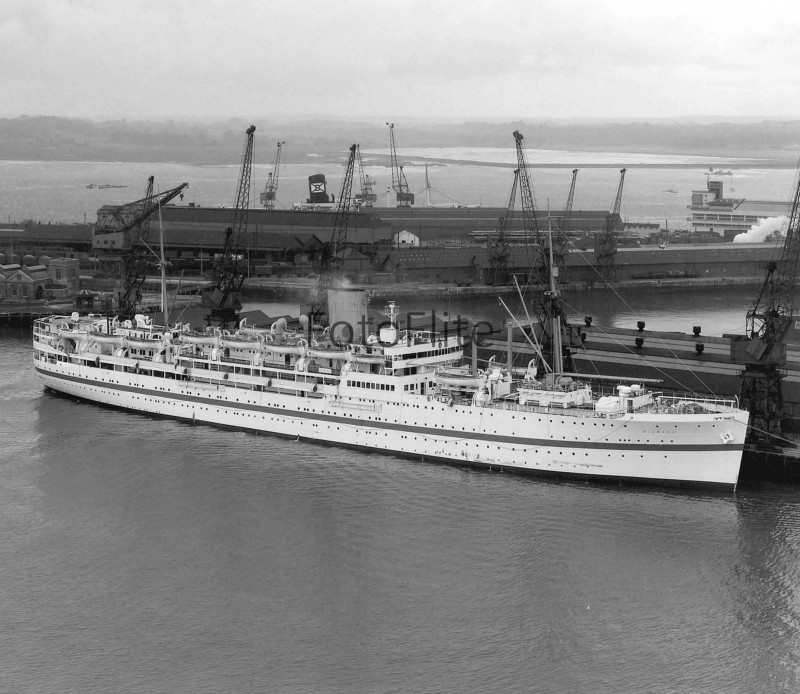
The first Dilwara and Dunera were sister ships of 5,440 grt completed in 1891 for the Queensland route of British India associated Steamers Ltd. (BIAS) from the U.K. via the Torres Strait. Dilwara (2) was completed as the first of the troopship quartet on 15th January 1936 at the Barclay, Curle & Co. Ltd. yard at Whiteinch on the Clyde on dimensions of 516.9 feet by 63.3 feet with a draft of 24.9 feet. She had been launched by Lady Currie, wife of Sir William Crawford Currie, Deputy Chairman of P. & o., owners of British India Line since 1914, and was a very good looking ship with a well deck forward, white hull with broad blue band, squat yellow funnel and ten pairs of gravity lifeboats. She was twin screw and propelled by two five-cylinder Doxford opposed piston oil engines by the builders to give a service speed of 16 knots. She took part in the Coronation review of King George VI at Spithead in 1937, and continued carrying troops to China and India until the outbreak of World War II. She then trooped mainly to South Africa and on to the red Sea and the Suez Canal, and then took part in April 1941 in the evacuation of British troops from Kalamata in Greece. During her time in the Mediterranean, she took the survivors of the battleship Barham, torpedoed by an audacious U boat commander in November 1941 and exploding spectacularly, to Durban. She was then converted during 1942 into an infantry Landing Ship (Light) carrying ten landing craft, and took part in the Madagascar landings in September of that year. In July 1943, she was present at the assaults on the Burmese coast and suffered mine damage and was repaired. She remained in Far East waters until the end of the war, serving between Calcutta, Burma and the Andaman islands, and then on to Penang and Singapore in 1945.
Ettrick and Devonshire, sisters of Dilwara and Dunera and distinguished by having taller funnels, also gave valuable war service. On 17th May 1940, Ettrick sailed from Gibraltar for Bordeaux to rescue 250 refugees, and tried to take more from Brest and St. Nazaire but these ports had by then fallen to the Germans. She took two thousand more refugees from Bayonne and then took part in operation Menace to Dakar. On 8th November 1942, she was present at Arzeu for the North African landinds, but was torpedoed and sunk seven days later by U155 in convoy on her homeward voyage 120 miles NW of Gibraltar with 24 crew lost. Devonshire made her maiden voyage on 17th august 1939 with troops from Southampton to India, and then spent the next four and one half years trooping to the Far East, Australia, South Africa and the Mediterranean before returning to the U.K. She was converted into an infantry Landing Ship at Suez in time to take part in the invasion of Sicily as a Combined operations Ship, and then was present at the Salerno landings on 6th September 1943. On D-Day, Devonshire, in company with the other Bibby Line ships Cheshire and Lancashire, began sailing down the Channel from the Thames for Normandy in line and carrying 10,000 troops. After Normandy, she then carried troops to Malaysia and later to Korea.
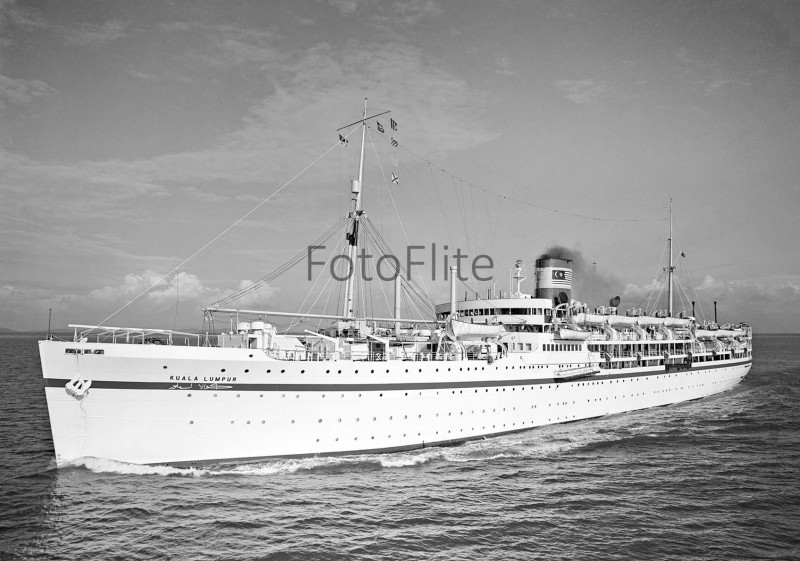
In November 1949, Dilwara arrived back at her builders yard to be rebuilt at a cost of nearly £1 million. Her well deck was filled in and her funnel heightened, and on her troop decks bunks replaced hammocks. She emerged in September 1950 with better accommodation for 125 First Class passengers (officers), 96 Second Class passengers (Wives), 104 Third Class passengers (NCOs) and 790 troops. She was remeasured at 12,555 grt and continued her trooping charters to India and the Far East. In august 1956, she took part in the Suez Canal zone landings by the Anglo-French force when the attempted seizure and nationalization of the canal by Egyptian President Nasser was resisted. A complete debacle resulted with withdrawal of both British and French troops after heavy American and international pressure. On 11th November 1960, due to the growth of air trooping and the cancellation of her government charter, Dilwara was sold to the China Navigation Co. Ltd. of John Swire & Co. Ltd. and renamed Kuala Lumpur. She was refitted at the Taikoo yard in Hong Kong and used as a pilgrim ship to Jeddah with accommodation for 1,668 pilgrims. She was given a white cruising livery in 1968 and a new funnel top with a curved lipped front, and after three years in this role she was broken up in December 1971 at Kaohsiung by the Tung Cheng Steel Company after a 36 year career.
Dunera (2)
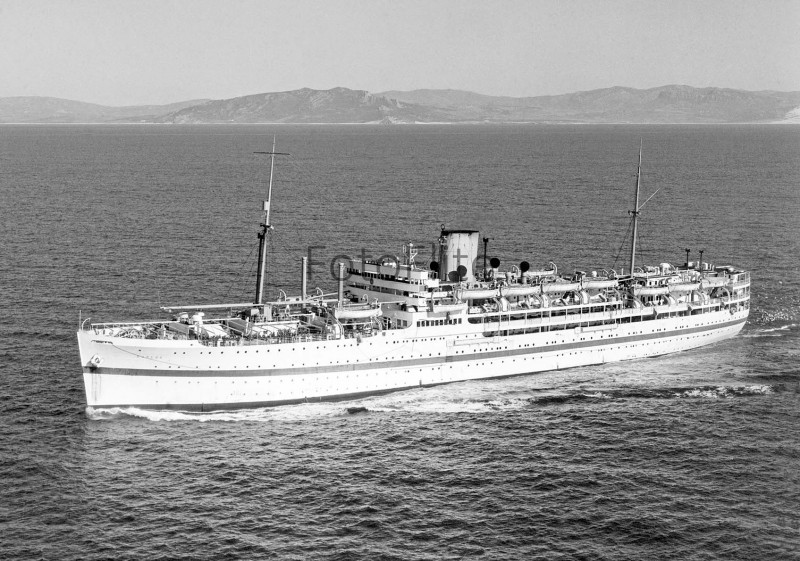
Dunera (2) was launched on 10th May 1937 at the same yard as her sister and completed just over three months later. She made her maiden voyage from Southampton to China with troops in September 1937, Southampton being the usual port of embarkation for all British troopships. She performed schools cruising service during 1939, a role for which she was to be later permanently converted, and then began her service as a wartime troopship. In January 1940, she embarked New Zealand troops for Egypt and sailed in the very large US1 convoy of twelve troopships from Australia to the Suez Canal in company with Empress of Canada, Orion, Rangitata, Strathaird, Strathnaver, Empress of Japan, Orcades, Orford, Otranto, the Polish Sobieski, and the French troopship Suffren. They all arrived safely on 12th February at Suez, and on her return to Australia, Dunera then sailed in the following US2 convoy from Australia to Suez in company with Ettrick, Neuralia, Nevasa and Strathaird.
On 10th July 1940, Dunera embarked at Liverpool some 2,542 detainees including 200 Italian and 251 German prisoners of war and several dozen Nazi sympathizers, and the remainder were Jewish refugees. She thus had on board twice the number of her normal wartime complement of 1,600 troops, as she carried 309 British guards as well as her crew. This voyage of 57 days to Australia subsequently went down in maritime history as the sad episode of ‘The Dunera Boys’. Serious overcrowding, with many men sleeping on the floor or on tables, with makeshift latrines erected on deck and sewage flooded the decks. Skin diseases were common as there was only one bar of soap to twenty men and one towel to ten men with water severely rationed. However, it was the brutal treatment of the passengers that was the main problem, with daily beatings and rifle butting by their guards, with one man bayoneted for attempting to use the deck latrines at night, which were out of bounds all night. Most passengers suffered severe dysentery as well as physical violence, and on arrival at Sydney, the first Australian onboard was army Medical officer Alan Frost. He was appalled at the state of the passengers and the ship, and his subsequent report led to the court martial of the officer in charge of the British guards, Lt. Colonel William Scott and his ‘severe reprimand’, as well as one year prison sentence and reduction to the ranks and then discharge from the army for two of his subordinates.

Dunera then took part in the evacuation of British personnel from Singapore in January 1942 and then returned to the Clyde to be converted into an infantry Landing Ship (Light) and was present at the landings at Majunga in Madagascar in September, 1942. On 10th July 1943, the allied invasion of Sicily began, with Dunera under the command of Capt. F. Caffyn playing a vital role with her landing craft and alongside the armada of allied troopships including Almanzora, Ascania, Circassia, Derbyshire, Duchess of Bedford, Durban Castle, Llangibby Castle, Monarch of Bermuda, Otranto, Orontes, Reina del Pacifico, Strathnaver and Winchester Castle. Dunera was one of many infantry Landing Ships including Glengyle, Keren, Princess Beatrix, Queen Emma, Royal Scotsman and Royal Ulsterman, and four British India Line hospital ships in Amra, Tairea, Vita and Talamba, the last named being bombed and sunk off the beaches. In September 1944, Dunera carried the Headquarters staff of the U.S. 7th army from North Africa for the invasion of Southern France, the invasion being directed from her bridge. In May 1945, she took part in the re-occupation of Rangoon, landing her craft and troops 25 miles SE of the port in the largest amphibious landing in the Far East. She was then present at the Malaysia landings and then trooped from India to Malaya, and after the Japanese surrender she carried allied occupation troops to Yokohama. She had carried troops from over one hundred different units during the war, and remained in the Far East after the war and trooped from Bombay to Japan during all of 1946.
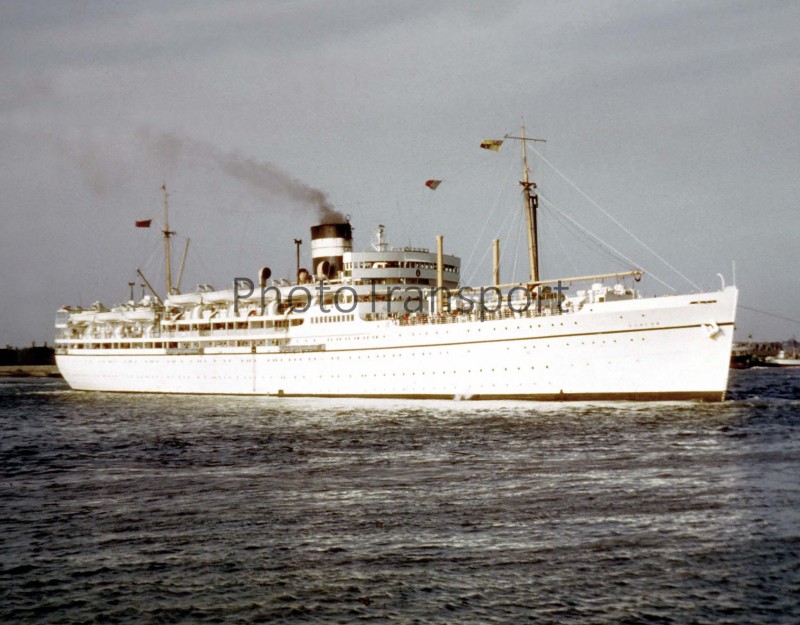
Dunera arrived at the Clydeside yard of her builders in March 1950 for a similar rebuild to that of her sister Dilwara. She emerged in May 1951 with accommodation for 831 troops, 41 more than her sister, with the same number of passengers in three classes. She was then employed for the next eleven years in trooping to Cyprus, Aden, Ceylon and Malaya until the cancellation of her government charter due to the growth of air trooping. She then arrived on 8th February 1961 at the Palmers repair yard in Hebburn on the Tyne for conversion into a schools educational cruise ship at a cost of £100,000. She emerged two months later with accommodation for 194 teachers in Cabin Class and 834 children in dormitories. She had a swimming pool installed and her masts were shortened for transits of the Kiel Canal on Baltic cruises. I visited the ship at the end of the conversion and was impressed by three things, firstly her very traditional wooden lined bridge with the addition of radar screens and her Decca Navigator with the red, green and blue tracer lines, secondly by the size and relative comfort of the tiered bunks in the student dormitories, and thirdly by the well equipped outside cabins for their teachers on the upper decks. She sailed from the Tyne for Greenock and departed from there on her first educational cruise with 732 students on 12th April, 1961. After six and one half years of educational cruising to the Baltic, Norway and the Mediterranean, Dunera was sold for scrapping on 11th November 1967 at Bilbao by Revalorizacion de Material S.A. after a career of thirty years.
Nevasa (3)
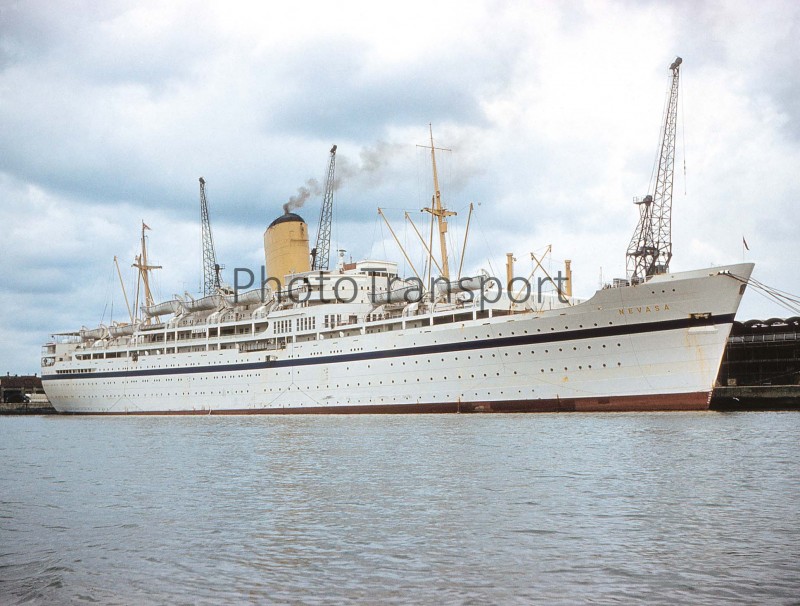
Nevasa had a short career, only nineteen years in her two roles of troopship and educational cruise ship. She was launched on Wednesday 30th November 1955 by Mrs. J.A. Boyd Carpenter, wife of the then Minister of Transport, at the Barclay, Curle & Co. Ltd. yard on the Clyde and completed on 12th July 1956 as a permanent troopship. She was of 20,527 grt and the largest British India Line ship to fly their house flag of white with a red diagonal cross. She had accommodation for 220 officers in First Class, 110 lesser ranks and wives in Second Class, 69 NCOs in Third Class and 931 troops in tiered dormitory bunks. She was partly funded by the Ministry of Transport, and given the trooping yellow funnel, white hull with narrow blue band, and looked an impressive ship at her service speed of 18 knots from two sets of Parsons three stage steam turbines, single reduction geared via double helical gearing to twin screws. She had achieved well over 21 knots on trials, but at a very high cost in fuel oil. She was well equipped with sixteen lifeboats positioned along two decks from number 2 hold to her stern, a raised platform being built above numbers 2 and 3 holds. She had a sister in Oxfordshire built in 1957 for Bibby Line by the Fairfield yard on the Clyde on similar dimensions of 609.3 feet by 78.3 feet with a draft of 26.7 feet, and both were under fifteen year charters to the Ministry of Transport. Nevasa sailed on her maiden voyage from Southampton to Famagusta in Cyprus on 27th July, 1956 and had a crew of 409. a White Paper foreshadowed the end of sea trooping when published at the end of 1957, and with the end of National Service and the growth of air trooping, the career of Nevasa was almost over six years after it had begun, and she was laid up on the Fal on 13th October 1962.
After lying idle for two years, Nevasa was moved to the Falmouth yard of Silley, Cox & Co. Ltd. for conversion into an educational cruise ship at a cost of £900,000. She emerged with accommodation for 308 teachers and passengers in Cabin Class, and 783 students in dormitories. She was given the black British India funnel with two white bands, and sailed from Southampton on her first educational cruise on 28th October 1964 with students from Staffordshire Educational authority to Madeira and the Canary islands. There were now three British India Line educational cruise ships, Dunera, Nevasa and Devonia, the latter having been purchased for £175,000 from Bibby Line as the trooper Devonshire, near sister of Dilwara and Dunera, in January 1962. Devonia made her first educational cruise on 16th April 1962 from Southampton after reconstruction by the Barclay, Curle yard, and after five and one half years service in this role was broken up at La Spezia in December 1967.
After the demise of both Dunera and Devonia towards the end of 1967, Nevasa sailed with Uganda as a two ship British India Line fleet of educational cruise ships. They had a total accommodation for 2,315 teachers and students, well over twice as many that sailed on the first British India Line educational cruise on Neuralia from Leith to Scandinavia on 25th July 1932 with 1,100 students and teachers. The organization of these cruises needed much preparation with publicity pamphlets to both the parents and teachers of the students of each Educational authority. However, the rewards in giving students a much wider knowledge of the world far outweighed the costs to parents. Nevasa had excellent open deck spaces for sports games, and the crew played deck quoits, hockey and cricket against the winners of the many competitive games amongst the children. Nevasa was transferred to the Passenger Division of its P. & o. owner in 1971, but fortunately kept their black British India Line funnels with the twin white bands. Nevasa arrived back at Southampton in January 1975 after her final educational cruise. She had become too costly to run due to the huge hike in oil fuel prices two years earlier, perhaps if her engines had been less powerful she may have sailed on with Uganda. The cost of replacing her engines with less powerful ones was looked into, but was found to be too costly to be justified, and she was sold for breaking up at Taiwan on 2nd April 1975 to the Nan Feng Steel Enterprises Company.
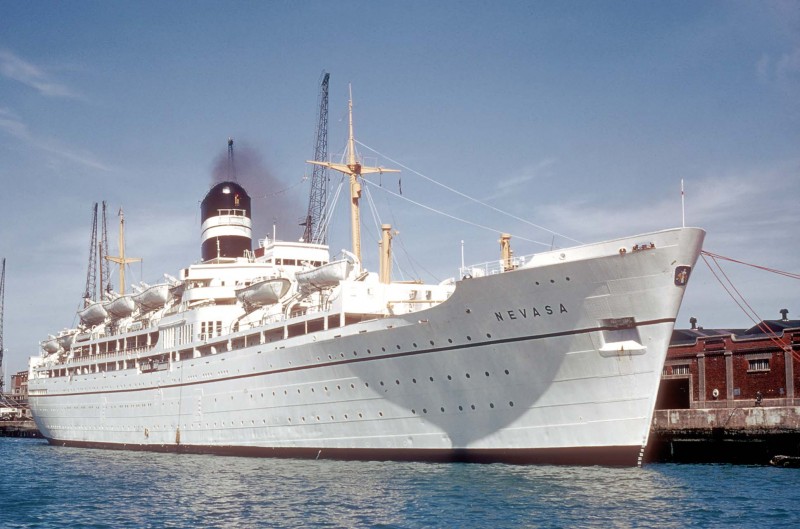
British India Line thus had a total of six educational cruise ships over the fifty year period from 1932 to 1982 in Neuralia of 1912 and her sister Nevasa (2) of 1913, Dunera (2) of 1937 and her near sister Devonia of 1939 (built as Devonshire for Bibby Line), Uganda of 1952, and Nevasa (3) of 1956. All the ships of this sextet had also served as troopships, the ease of conversion between these two distinct tasks being the most important factor in their success.

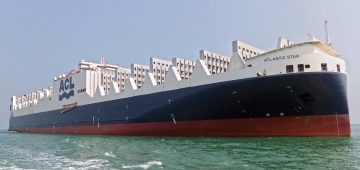




Comments
Sorry, comments are closed for this item